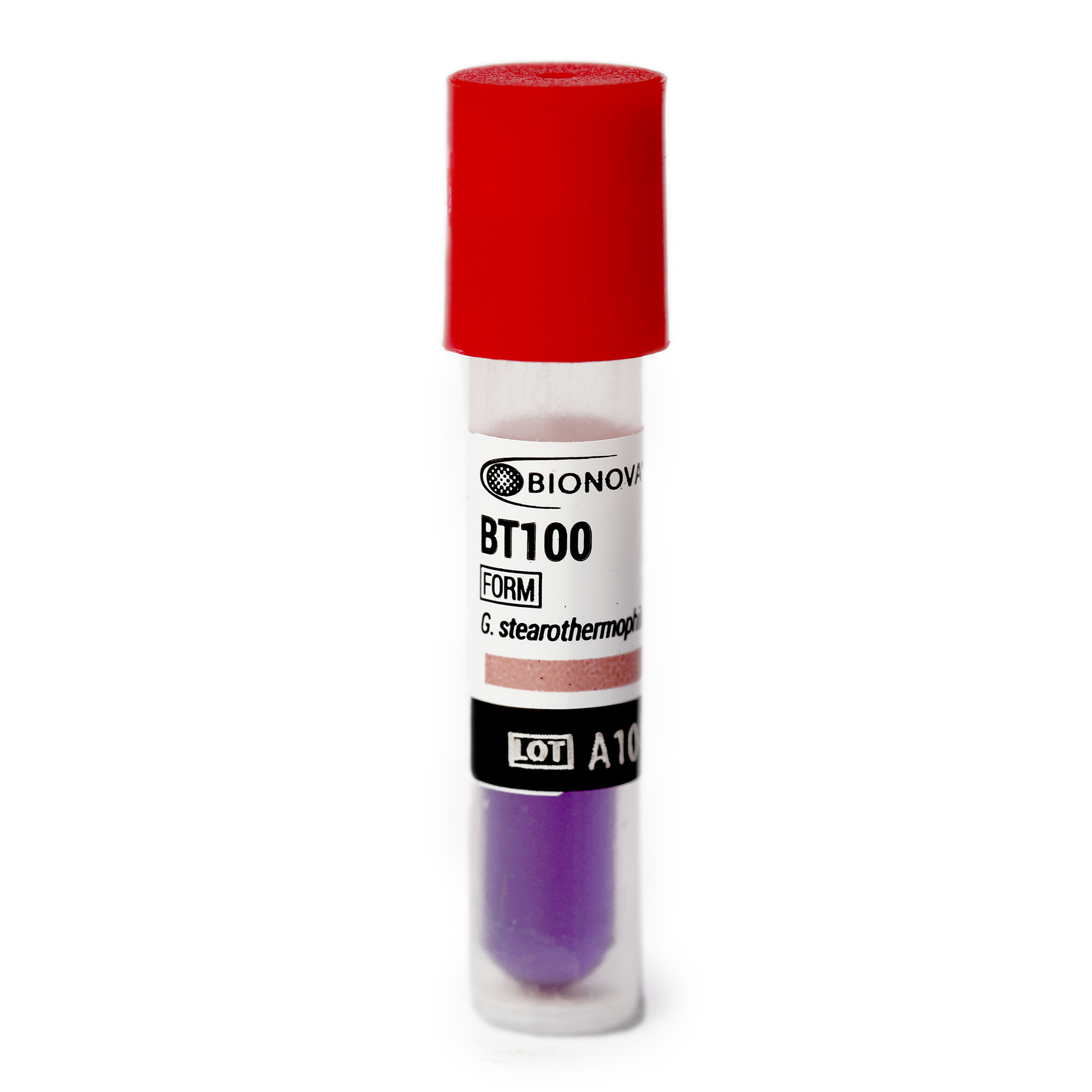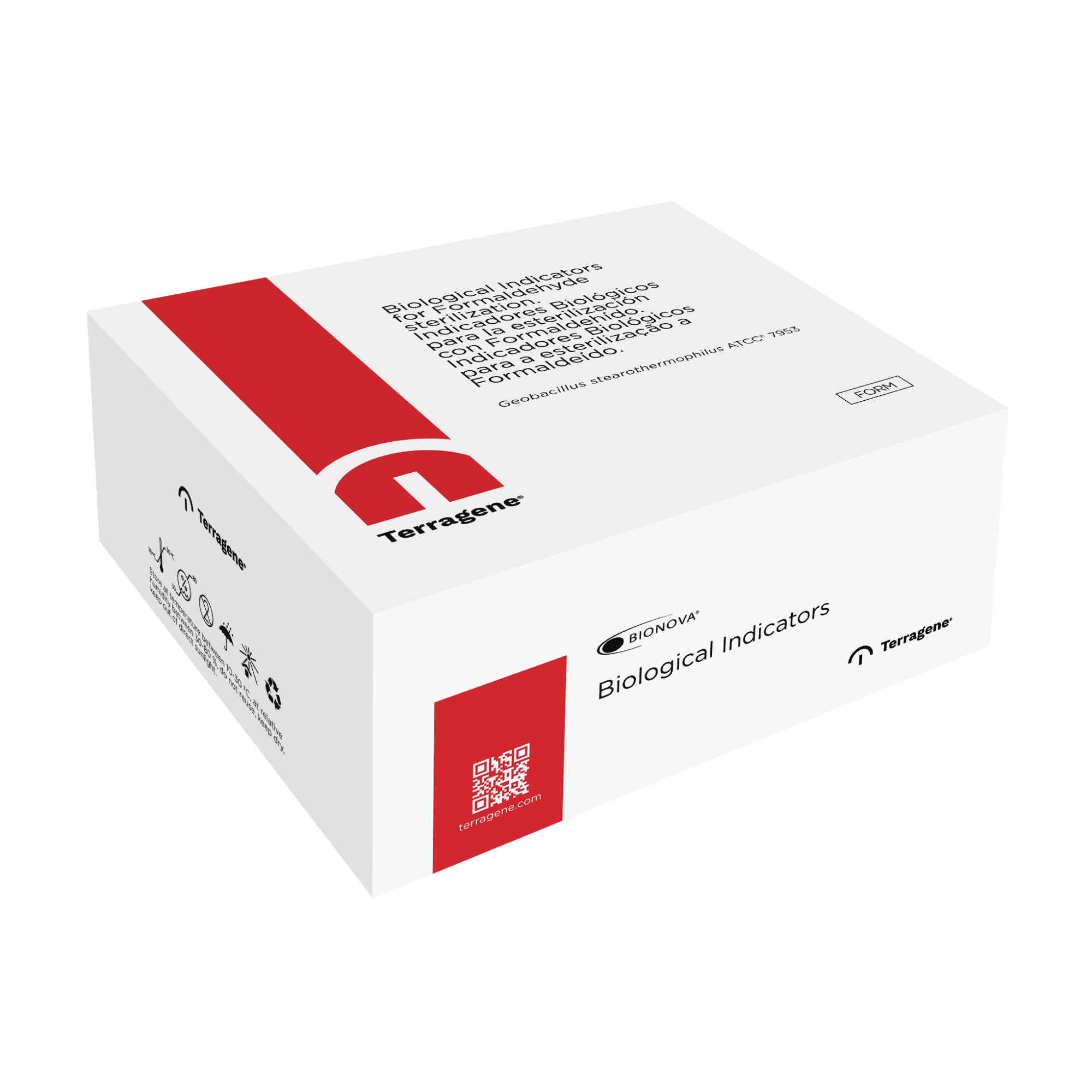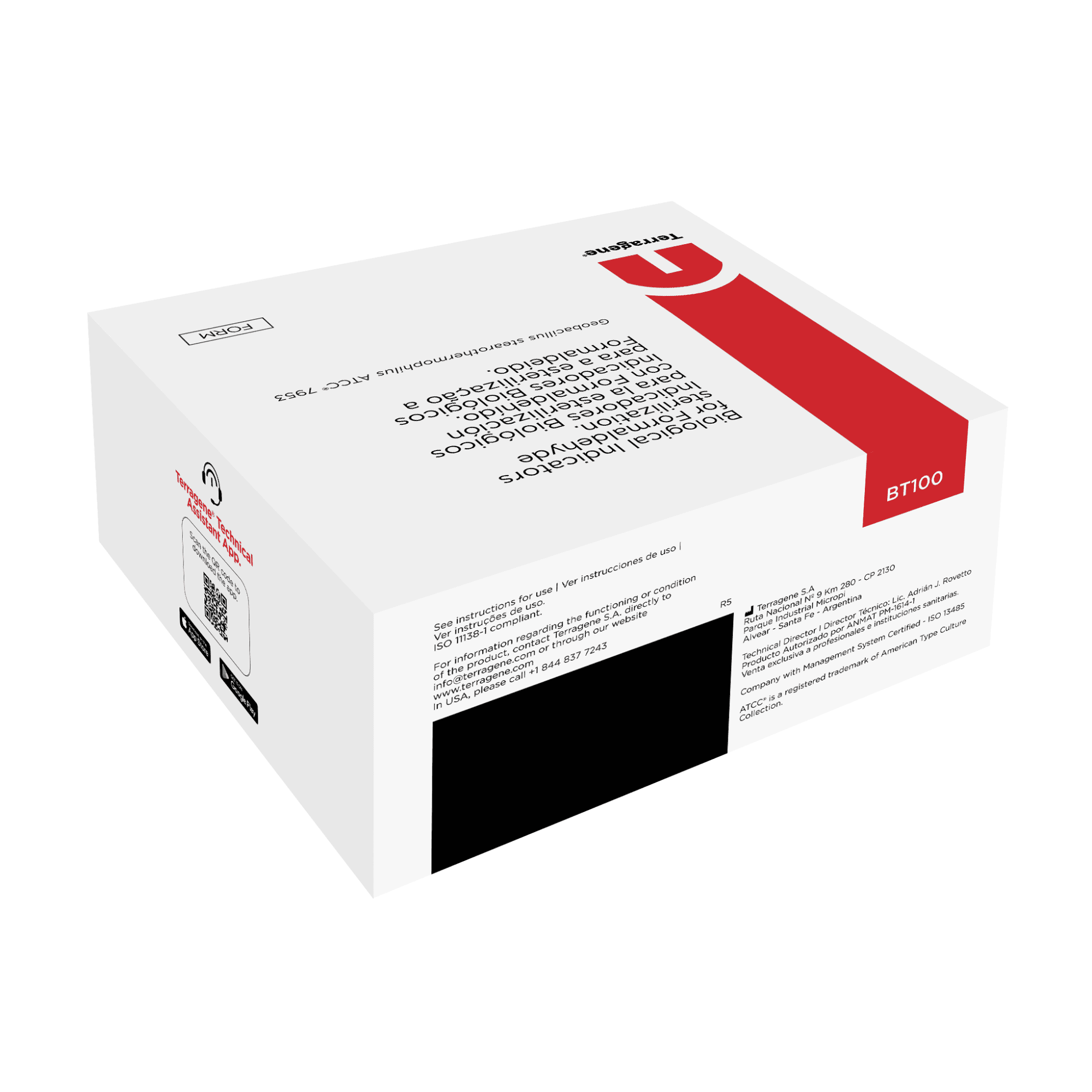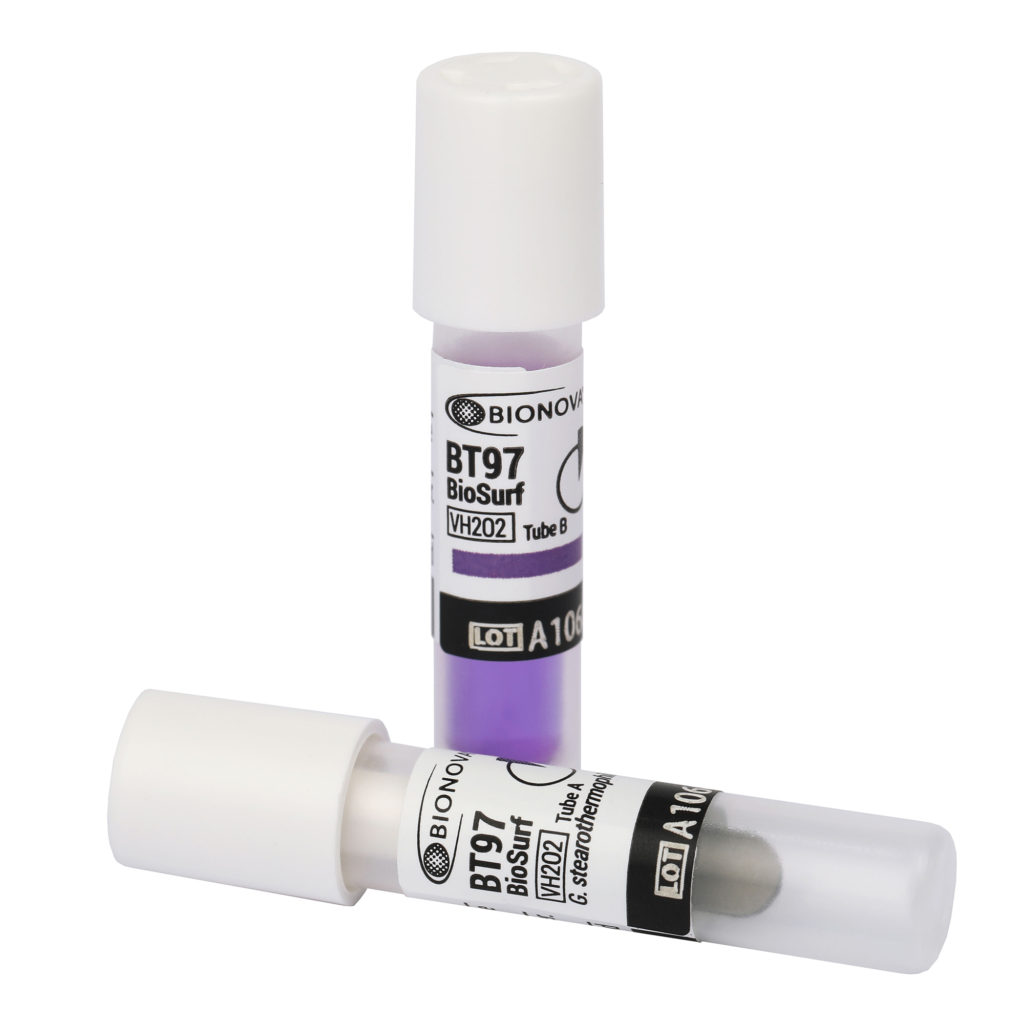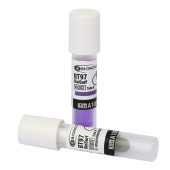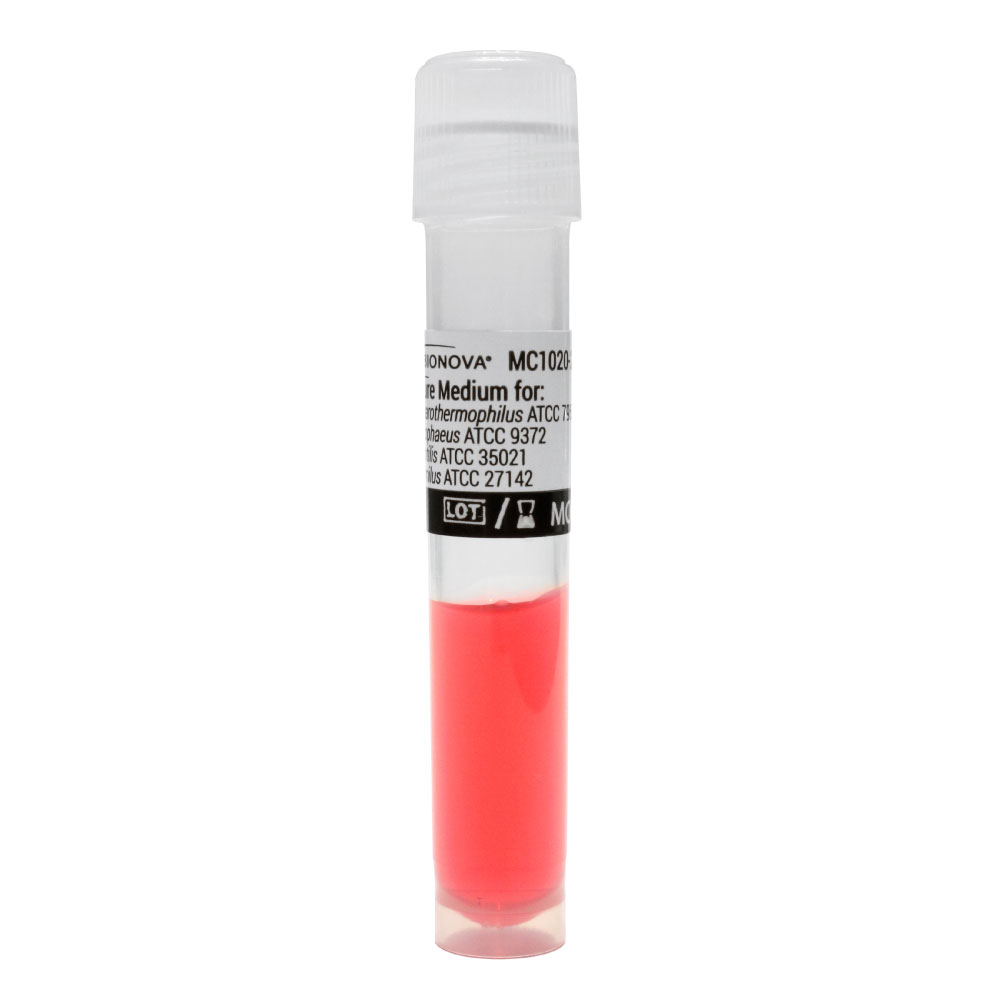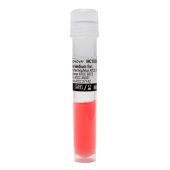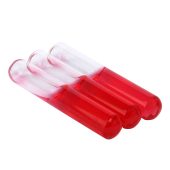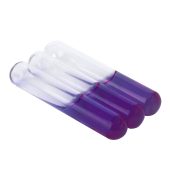
48h Biological Indicator for LTSF
Additional information
| Brand | |
|---|---|
| Process | Formaldehyde |
| Packaging | 100 |
| Microorganism | Geobacillus stearothermophilus (ATCC® 7953) |
| Population | 10^6 Spores/carrier |
| Read-Out Time | 48 h |
| Regulations | IRAM 37102-1, ISO 11138-1, ISO 11138-5 |
| Possible target markets |
Description
Self-contained Biological Indicator for Formaldehyde sterilization processes. Geobacillus stearothermophilus (ATCC® 7953, ATCC is a registered trademark of American Type Culture Collection) 10^5 or 10^6 spores per vial. Readout: 48 hours.
Characteristics
Polypropylene tube: 45.2 mm high x 8.5 mm external diameter. Wall thickness: 0.5 mm.
Polypropylene cap: 13.0 mm high x 10.9 mm external diameter. Wall thickness: 0.7 mm.
Cap filter: medical grade paper, 17.0 mm diameter, 60.0 g/m2 .Glass ampoule: 35.0 – 40.0 mm high. External diameter: 6.5 mm. Wallthickness: 0.2 – 0.3 mm.
Culture medium: 0.5 – 0.7 ml, purple color.
Spore carrier: polyethylene fibers, 7.0 mm diameter, 64.5 g/m2. 10^5 or 10^6 Geobacillus stearothermophilus ATCC® 7953 spores per vial. Upon completion of sterilization process, incubate the indicator for a maximum of 48 hours, between 55-62 °C.
Positive growth results (failure in the sterilization process): culture medium turns to yellow after incubation between 55-62 °C for 48 hours (maximum). D-ValueFORM: not lower than 6.0 minutes at 60 °C, 1 mol/l Formaldehyde.
Instructions for use
1. Identify the Bionova® BT100 Indicator by writing the sterilizer number (in case of having more than one), load number, and processing date on the indicator label.
2. Pack the biological indicator along with materials to be sterilized in an appropriate package according to recommended sterilization practices. Place this package in those areas which a priori you consider most inaccessible for sterilizing agent. Generally, a problematic area is the center of the load and areas near the door.
3. Perform sterilization cycles.
4. After the sterilization process has finished, you can:
A. Remove the biological indicator from sterilization package for incubation prior to material aeration.
B. Aerate the package containing the biological indicator with the rest of the load and then remove the biological indicator for incubation.
CAUTION: Wear safety glasses and gloves when removing the Bionova® BT100 Biological Indicator from the sterilized package. WARNING: Do not crush or handle the biological indicator excessively, since this might cause the glass ampoule to burst.
5. Check the chemical indicator on the label of the biological indicator. A color change to green confirms that the biological indicator has been exposed to Formaldehyde.
IMPORTANT: This color change does not indicate that the process was sufficient to achieve sterility. If the chemical indicator is unchanged, check the sterilization process.
6. Crush the ampoule contained in the biological indicator with an individual ampoule crusher or with the ampoule crusher placed within the top of the incubator´s incubation area.
Then shake the tube down vigorously, with movements similar to those performed to lower the temperature of a mercury thermometer, until the medium reaches the base of the tube and soaks the spore carrier entirely. Finally, place the biological indicator in the incubator.
IMPORTANT: Use a non-sterilized biological indicator as a positive control in order to ensure that correct incubation conditions were met; capability of medium to promote rapid growth; viability of spores has not been altered due to improper storage temperature, humidity or proximity to chemicals. Both the positive control indicator and the processed indicator should belong to the same batch.
7. Incubate the processed biological indicator and the indicator used as positive control for a maximum of 48 hours between 55-62 ºC. Readouts should be performed at convenient intervals of 10 hours.
A color change from purple to yellow of the growth indicator medium means that a sterilization process failure has occurred. If after 48 hours there is no color change in the processed indicators, a final negative result is obtained (the sterilization process was effective). The positive control should show a color change from purple to yellow for the results to be valid.
Description
Self-contained Biological Indicator for Formaldehyde sterilization processes. Geobacillus stearothermophilus (ATCC® 7953, ATCC is a registered trademark of American Type Culture Collection) 10^5 or 10^6 spores per vial. Readout: 48 hours.
Characteristics
Polypropylene tube: 45.2 mm high x 8.5 mm external diameter. Wall thickness: 0.5 mm.
Polypropylene cap: 13.0 mm high x 10.9 mm external diameter. Wall thickness: 0.7 mm.
Cap filter: medical grade paper, 17.0 mm diameter, 60.0 g/m2 .Glass ampoule: 35.0 – 40.0 mm high. External diameter: 6.5 mm. Wallthickness: 0.2 – 0.3 mm.
Culture medium: 0.5 – 0.7 ml, purple color.
Spore carrier: polyethylene fibers, 7.0 mm diameter, 64.5 g/m2. 10^5 or 10^6 Geobacillus stearothermophilus ATCC® 7953 spores per vial. Upon completion of sterilization process, incubate the indicator for a maximum of 48 hours, between 55-62 °C.
Positive growth results (failure in the sterilization process): culture medium turns to yellow after incubation between 55-62 °C for 48 hours (maximum). D-ValueFORM: not lower than 6.0 minutes at 60 °C, 1 mol/l Formaldehyde.
Instructions for use
1. Identify the Bionova® BT100 Indicator by writing the sterilizer number (in case of having more than one), load number, and processing date on the indicator label.
2. Pack the biological indicator along with materials to be sterilized in an appropriate package according to recommended sterilization practices. Place this package in those areas which a priori you consider most inaccessible for sterilizing agent. Generally, a problematic area is the center of the load and areas near the door.
3. Perform sterilization cycles.
4. After the sterilization process has finished, you can:
A. Remove the biological indicator from sterilization package for incubation prior to material aeration.
B. Aerate the package containing the biological indicator with the rest of the load and then remove the biological indicator for incubation.
CAUTION: Wear safety glasses and gloves when removing the Bionova® BT100 Biological Indicator from the sterilized package. WARNING: Do not crush or handle the biological indicator excessively, since this might cause the glass ampoule to burst.
5. Check the chemical indicator on the label of the biological indicator. A color change to green confirms that the biological indicator has been exposed to Formaldehyde.
IMPORTANT: This color change does not indicate that the process was sufficient to achieve sterility. If the chemical indicator is unchanged, check the sterilization process.
6. Crush the ampoule contained in the biological indicator with an individual ampoule crusher or with the ampoule crusher placed within the top of the incubator´s incubation area.
Then shake the tube down vigorously, with movements similar to those performed to lower the temperature of a mercury thermometer, until the medium reaches the base of the tube and soaks the spore carrier entirely. Finally, place the biological indicator in the incubator.
IMPORTANT: Use a non-sterilized biological indicator as a positive control in order to ensure that correct incubation conditions were met; capability of medium to promote rapid growth; viability of spores has not been altered due to improper storage temperature, humidity or proximity to chemicals. Both the positive control indicator and the processed indicator should belong to the same batch.
7. Incubate the processed biological indicator and the indicator used as positive control for a maximum of 48 hours between 55-62 ºC. Readouts should be performed at convenient intervals of 10 hours.
A color change from purple to yellow of the growth indicator medium means that a sterilization process failure has occurred. If after 48 hours there is no color change in the processed indicators, a final negative result is obtained (the sterilization process was effective). The positive control should show a color change from purple to yellow for the results to be valid.
HAVE A QUESTION ABOUT OUR PRODUCTS?
WE´RE HERE TO HELP.
Related Products
MC1020-2




